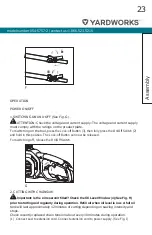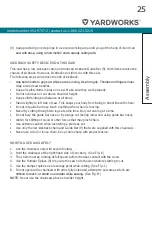
model number 054-5757-2 | contact us: 1.866.523.5218
11
stop cutting before the felling back cut is
complete and use wedges of wood, plastic or
aluminium (Z) to open the cut and drop the
tree along the desired line of fall (
).
When the tree begins to fall, remove the
chainsaw from the cut, stop the motor, put
the chainsaw down, then use the retreat path
planned (
). Be alert for overhead limbs
falling and watch your footing.
3
2
2
W
Y
Z
X
2˝ (5 cm)
1
1
1
2˝ (5 cm)
2˝ (5 cm)
Figure 2
4. Limbing a tree
Limbing is removing the branches from
a fallen tree. When limbing, leave larger
lower limbs to support the log off the
ground. Remove the small limbs in one cut
as illustrated in Figure 3. Branches under
tension should be cut from the bottom up to
avoid binding the chainsaw.
Figure 3
5. Bucking a log
Bucking is cutting a log into lengths. It is
JNQPSUBOUUPNBLFTVSFZPVSGPPUJOHJTªSN
and your weight is evenly distributed on both
feet. When possible, the log should be raised
and supported by the use of limbs, logs or
chocks. Follow the simple directions for easy
cutting.
When the log is supported along its entire
length as illustrated in Figure 4, it is cut
from the top (overbuck) , avoid contacting
ground as this will greatly reduce the chain
sharpness.
Figure 4
When the log is supported on one end, as
illustrated in Figure 5, cut 1/3 the diameter
from the underside (underbuck) (1). Then
NBLFUIFªOJTIFEDVUCZPWFSCVDLJOH UP
NFFUUIFªSTUDVU
2
2/3
1
1/3
Figure 5
General Safety Rules












































